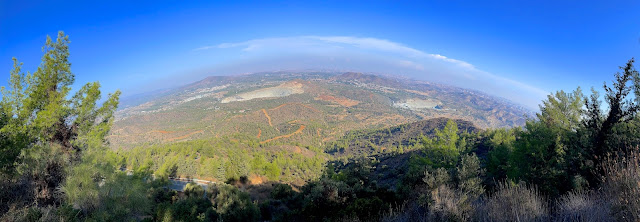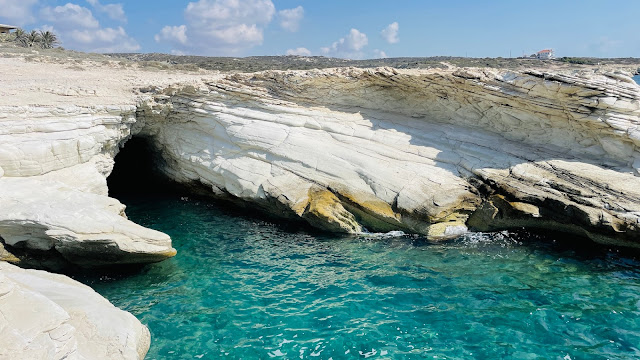In this post I drive from Larnaca to Limassol in Cyprus via: Stavrovouni Monastery (Holy Cross), Neolithic Settlement of Choirokoitia, White Stones, Archaeological Site of Amathous. The next day, I visit Limassol city in the morning and in the afternoon visited the following sites on the Akrotiri Peninsula: Ancient Kourion, Kolossi Castle, Akrotiri Salt Lake, St Nicholas of the Cats Monastery.
The more I see of Cyprus the more I like it. Firstly, I am driving on the left again – good practice for my return to Oz !!! Secondly, there is no honking or sudden lane changes and everyone follows the road driving rules – nowhere near as crazy as Lebanon even though Cyprus is the same size. Thirdly, there are lots of Cyprus Pines on the island and they smell good too !!! I have also noticed many non-Greeks living here – mostly Phiippinos and Indians, Believe it or not – and they all speak with the heavy Greek-Cypriot slang – amazing to watch. Most of the very few tourists I have encountered so far are Russian !!! No shock here – these guys own heaps of property and pay the low 10-15% tax offered by the government to attract foreign investment here.
The drive between Larnaca and Limassol was great going up into the high hills to visit the Stavrovouni Monastery but down below by the coast quite tame and ordinary. The Stavrovouni Monastery was built in 327AD !!! Can you believe that ??? Naturally it has been repaired and restored several times due to attacks and age but there are many bits that date back to that year. There are 20 monks living there at 670m above sea level and no female visitors are allowed. The Church of St John The Theologian holds a big piece of The Holy Cross of Christ – the biggest I have seen to date and sadly not allowed to photograph it.
The Neolithic Settlement of Choirokoitia was simply unbelievable. I starred at a village foundation dating back to 9000BC – one of the oldest my eyes have beheld. This place is so old that pottery had not even been invented but the skeletons found are definitely Homo Sapien and upstanding on two feet and looking like us. How did they get here before boats were even invented is anyone’s guess. UNSECO jumped on this place in 1998 to preserve it.
The White Stones near St George of Alamanou are indeed stark white – so pristine in non-colour and with a clear and almost calm sea I just had to have my first swim in Cyprus here. Gave my car keys to one of the waitresses in the mostly Russian attended resort nearby and jumped into the 24C clear waters for what turned out to be a 1.7km swim.
The ancient town of Amathous is only 7 km east of Limassol. This place dates back to 1100BC and the first port and harbour city of Cyprus. The town was occupied by many civilisations including Alexander The Great but its fame lies in the worship of the goddess Aphrodite to whom many temples were dedicated. This place also featured a cemetery with several bodies found.
Limassol or Lemesos in Greek (Pop 239,842, Sea Level, First Settled 2000BC) is a big modern city with tall buildings you can call skyscrapers. Nothing like Larnaca. But then again, this is the second largest city on the island. Limassol was built between two ancient Greek cities, Amathus and Kourion, and during Byzantine rule it was known as Neapolis (new town). As a result it is very cosmopolitan and forward thinking. There was a thunderstorm when I went to sleep only to awake to more rain in the morning. I did my best to shoot the city in between rainfalls. It was a blessing in disguise. Being Sunday I decided to attend the full Liturgy at St Anthony Orthodox Church in the middle of town. This was I could duck out when the rains stopped and be in the centre of town ready to shoot. The service and people was quite old fashioned just like Bourke St in Surry Hills – men on the right and women on the left. As usual I sat with the women to turn a few heads. There is a mosque right opposite At Anthony’s – this appears to be commonplace in Cyprus. After the service I visited the Castle, which is incredibly famous. It was built in 1191 and this is where Richard the Lionheart married Berengaria of Navarre and crowned her Queen of England !!! Here. Amazing. I then visited the Old Agora or marketplace where stalls are commonplace but not today given the rain. Walked down the main modern boulevard until the rain got a bot heavy so I headed back to my hostel.
After the rain eased I jumped into my little Suzuki Alto 1.2L Auto and headed to the Akrotiri Peninsula only 21km away. There I visited Ancient Kourion which was an important ancient Greek city-state built by Greek settlers from Argos in the 12th Century BC and then later occupied by Phoenicians and the Romans. The site has a well-restored amphitheatre and a great floor mosaic, which still retains its colours. Alexander The Great finally ended the cities prominence.
The weather had stabilised and even some traces of sunlight appeared between the heavy grey clouds so I headed on further to the Kolossi Castle. It is a former Crusader stronghold and held great strategic importance in the Middle Ages, and contained large facilities for the production of sugar from the local sugarcane, one of Cyprus's main exports in the period. The original castle was possibly built in 1210 by the Frankish military, when the land of Kolossi was given by King Hugh I to the Knights of the Order of St John of Jerusalem. The castle today consists of a single three-storey keep with an attached rectangular enclosure or bailey about 30 by 40 metres (98 by 131 ft). As well as for its sugar, the area is also known for its sweet port-like wine, Commandaria. At the wedding banquet after King Richard the Lionheart's marriage to Berengaria of Navarre at nearby Limassol, he allegedly declared it to be the "wine of kings and the king of wines." It has been produced in the region for millennia, and is thought to be the oldest continually-produced and named wine in the world, known for centuries as "Commandaria" after the Templars' Grand Commandery based there. Amazing – this is where Commandaria comes from and is used for Holy Communion everywhere in the Orthodox World all over the planet !!!
From here I drove by the shores of the great salt lake of Akrotiri and ended up in an Orthodox Monastery called St Nicholas of the Cats. The reason is simple. There are hundreds of cats roaming around. Legend has it that St Helen founded the monastery in the 4th Century, and not only did she leave a piece of the Holy Wood there, but she also brought hundreds of cats in order to exterminate all the poisonous snakes which had gathered around the island due to a terrible drought. Another legend says that Constantine the Great had asked Governor Kalokeros to help exterminate the snakes of the area. He brought 1000 cats and made the monks take care of at least 100 cats each day, and feed them twice a day in order to protect them from only eating venomous snakes. During the Ottoman invasion, the Monastery was completely destroyed and the cats began to wander, which explains the large number of stray cats living in Cyprus !!!
I capped off my stay in Limassol with two classic Cypriot dishes – AFELIA – braised pork with veggies and SPANAKORIZO – rice with spinach (this is also bog in Greece). Washed down with MARATHEFTIKO – my favourite Cypriot grape which is used to make a Rose that is so dry that the beads of sweat cease to exist on your lips !!!
Enjoy the rich history, which surrounds
Limassol…







































No comments:
Post a Comment